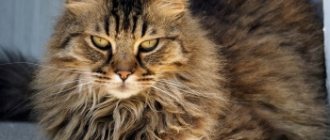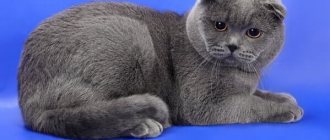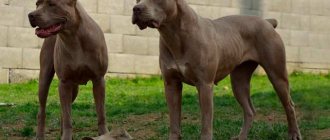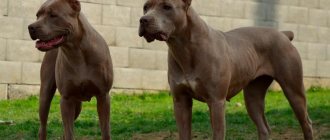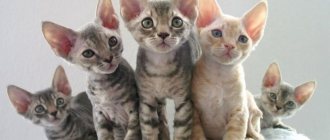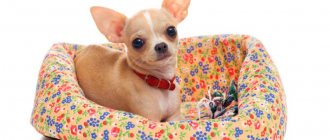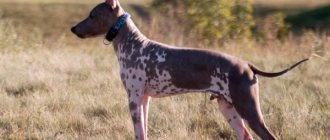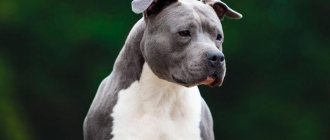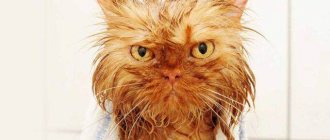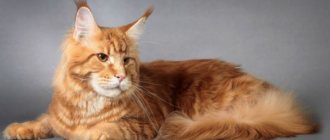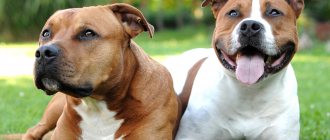In 1981, in Lakewood (California), a black kitten with unusual ears and semi-long fur found its way to the home of married couple Joe and Grace Ruga. The husband at first pretended not to notice the kitten, but his wife decided to feed the foundling. The black kitten turned out to be so cute that the couple soon fell in love with him. Since it turned out to be a cat, she was named Shulamith.
This is where the history of the American curl began. Nowadays, the pedigree of any American Curl cat can be traced back to the founder of the breed, named Shulamith.
Brief history of the breed
The USA is considered the birthplace of the American Curl. Its story began in 1981 when the Ruga couple picked up a mongrel cat with arched ears turned outward on the street. A few months later, the female, nicknamed Shulamith, acquired offspring. Almost all babies whose father was an unknown mongrel cat inherited their mother's ear shape. When they grew up, they were simply distributed to friends.
But in 1983, the Ruga couple finally showed the cat to a specialist, and he found out that the outward-curved ears were the result of a genetic mutation. It was then discovered that the gene responsible for this feature is dominant. In the same year, unusual cats were demonstrated at the Californian felinological exhibition, which became excellent advertising for them.
Breeding
Now curls have spread throughout the planet and, thanks to permission for outcrossing, their numbers are growing quite quickly.
In the American Curl, typical regional variances exist as in other breeds. In particular, this concerns changes in the length and shape of the body and ears. To some extent, the reason for the appearance of these features is the use of non-pedigreed cats in Curl breeding programs. And, as you know, the types of domestic outbred cats for each region have significant differences. In addition, various publications allow for a not entirely correct definition of outcrossing for a given breed. There are also publications in which the American Curl is allowed to be crossed “with any purebred or purebred cat.” This approach is a direct contradiction to the only permitted option for outcrossing this breed - with domestic purebred cats.
As for the wedge-shaped head, the proportions of length and width are 3:2, the body is rectangular, then based on this, it can be understood that there is no similarity between the American Curl and the American Shorthair cat. The latter is characterized by a stocky body and a rounded head. The Curl has little in common with the eastern breeds, which have a long body and a wedge-shaped head.
Recently, some breeders have become interested in the idea of introducing the Turkish Angora into the Curl breeding program. But even with a quick glance, assessing the standard of Turkish Angoras, it becomes clear that the prospect of development of this direction is simply excluded. The fact is that the Angora standard contains a large number of positions that do not correspond to the American Curl type. In particular, this applies to the requirements for the type of body, muscles and head.
Since 2010, a ban has been introduced on many areas of outsourcing and the reproduction of curls. It has become more intra-breed, and more stringent requirements have appeared. Breeders have made every effort to improve the breed type as quickly as possible. Nurseries carried out complex programs to mix bloodlines across regional boundaries, their goal was to establish the type and preserve genetics.
Oddly enough, aboriginal cats with similarly curled ears began to be found in different parts of the world. Information about such finds came from South America, and even from Australia.
Interesting Facts
During the short period of existence of the breed, many interesting things have been associated with it:
- Although the Shulamith cat is considered the ancestor of the American Curl, she was not the only one who had this mutation. Since the 1960s, farmers in California and Oklahoma have regularly seen animals with unusually broken ears. This is confirmed by news reports at the time.
- The degree of curl, which determines the breed qualities of the American Curl, does not depend on how curled the ears of the parent pair were. Often, two champions produce pet-class kittens. And vice versa, a couple with a weak break in the ear tissue produces beautiful offspring.
- American Curl kittens are born with straight ears. The web begins to curl around the 4th day and is finally formed by 4 months of age.
- The American Curl served as the basis for the development of a new breed. From its crossing with the Cornish Rex, the Raffle Rex was born.
How much does an American Curl cost?
The price of an American curl with all documents is at least 10 thousand rubles. For this price you can buy a pet-class animal with defects that are not acceptable for breeding or participation in exhibitions. Straight-eared representatives can be purchased within 25 thousand rubles, but more elite individuals will cost 25-45 thousand rubles.
In addition to class, how much an animal costs depends on the rarity of its color and the status of the seller. Owners of chinchilla, golden and chocolate coats born in the capital's nurseries receive the highest prices.
Do you like the article? 0
Breed description, standards, appearance
The American Curl is a strong cat with a harmonious, slightly elongated body. She has an attractive appearance, and the unusual curve of the ear flap gives her a wary expression. A detailed description of the breed is presented in the officially approved standard.
Dimensions and weight
The American Curl is not a large breed. It is medium in size and has pronounced sexual dimorphism. The weight of an adult is 2.5-5 kg.
Anatomical characteristics
A purebred American Curl must meet the following description:
- The head is wedge-shaped, smoothly contoured, with a developed chin and a straight, moderately long nose.
- The eyes are expressive, almond-shaped, slanting. The color of the iris is in harmony with the color of the coat.
- The ears are small and set high. Their canvas gracefully bends outward at an angle of 90-180 degrees.
- The body is rectangular, slightly elongated, with developed muscles and a moderately long neck.
- The limbs are straight, with small rounded paws.
- The tail is long, flexible, wide at the base, with a slightly pointed tip.
Color and coat type
Cats of this breed have a silky, not too thick coat, under which there is a sparse down. Depending on the length of the hair, the American Curl can be:
- long-haired;
- shorthaired
The first has developed decorative hair on the tail and chest. The second one has smoother and less voluminous fur.
The American Curl breed standard allows the following colors:
- plain;
- bicolor;
- links point;
- tortoiseshell;
- tabby;
- color point.
Coat color
The cat has a rich past, so any color can be found in the breed. The photo shows the most common colors.
Solid color
Pure colors are not so common, but are in great demand. White, black, blue and red colors are common. The main thing in describing a solid color is the absence of marks and changes in shade. This significantly increases the cost of the cat.
Two-color
The fur combines hairs of two colors at once. The most common are black mixed with white and red mixed with white. The color is common. These kittens are inexpensive.
Silver
Valued on a par with solid colors, it appears rarely. The photo shows a gray-blue tint that evenly covers all parts of the pet’s body. Even the tummy and muzzle are painted a single color silver. The fur must have a cool blue undertone.
Colorpoint
The photo shows the original color. The fur is light in color - gray, white, cream. On the face, paws, ears, and sometimes on the tail there are spots of darker colors, with smooth transitions into light shades. For example, Siamese cats are also representatives of this color.
Tabby
There are different variations in the description of tabby color. The marbled color with spots or slightly blurred black stripes on gray fur is considered a classic. Less common are brown stripes on the red coat or a mixture of three shades.
Character and temperament
The American Curl cat has a calm, friendly disposition and good adaptability. He is not very demanding, but loves to play and needs attention from his owners.
An important characteristic of curls is their poor tolerance of loneliness. Of course, in the absence of communication with people, the animal will find something to occupy itself with, but it is unlikely that its owners will like its entertainment. Therefore, cats with curled ears should not be left unattended for a long time.
Breed and children
The American Curl is a sociable and very peaceful cat that easily finds a common language with the owner’s children of different ages. He loves to play with kids, especially if they don't hurt him.
Breed and other animals
The American Curl has a calm, balanced character. And this allows him not to conflict with other pets. He gets along well with cats and dogs, but due to his developed hunting instinct, he is not able to peacefully coexist in the same territory with small animals.
Hereditary diseases
Thanks to its rich past, the American Curl has acquired strong immunity and iron health. She has no hereditary diseases. However, like all animals, a cat can catch a cold, have an allergic reaction, etc. To make an accurate diagnosis, be sure to visit a veterinarian who will prescribe treatment.
There are several diseases that arise as a result of improper care.
Inflammation of the ear
The problem occurs due to the curved shape and narrow ear canal. It is important to regularly examine your pet’s ears and clean them with a soft swab without damaging the cartilage.
The veterinarian cleans the ears and drips the prescribed medicine against otitis media. The hair near the ears is temporarily cut off.
Dental problems
Occurs in the absence of dry food. To keep gums and teeth healthy, your cat should regularly chew dry treats and dry food.
In case of inflammation, regular teeth cleaning with gel, anti-inflammatory drugs, changes in diet, etc. are prescribed.
How to choose the right kitten
The American Curl is a fairly expensive breed, and in order not to run into scammers, it is better to buy a kitten from a specialized nursery. Before purchasing, you must make sure that your future pet has a veterinary passport with vaccination marks and a metric confirming that it belongs to the breed.
It is advisable to buy a Curl dog no earlier than he is 3-4 months old. By this age, the kitten already has a formed ear curve, is fully vaccinated and accustomed to the tray. A healthy American Curl has a soft belly, clear eyes, a shiny coat and a good appetite.
Kitten care
Taking care of a small American Curl is not at all difficult, especially if you have everything you need on hand. Therefore, before picking up a kitten from the breeder, they purchase for it:
- bowls for food and water;
- tray and filler;
- scratching post;
- toys;
- bed or house;
- carrying bag;
- grooming tools (combs, toothbrushes and nail clippers);
- hygiene cosmetics (shampoos and toothpaste).
On a note. The location of the tray and bed is thought out right away, because changing them will be problematic.
Education
There are no problems with this breed in matters of education. Since kittens can easily train the commands “come” or “no”, such ordinary requirements as going to the toilet in a litter box or something similar will not be difficult for them.
Even though kittens are easy to train, they do not turn into robots. They still remain positive and individual animals.
Motivation in the matter of training should always be inherent, so it is easiest for the animal to respond to your requests. So encourage your kitten to take action with his favorite treats. If your pet doesn’t do what you ask of it, then you shouldn’t punish it right away.
Since they are smart animals, they will instantly understand your displeased look and slightly rude tone. Also, because the curl has a need to connect with its owner, it never wants to deliberately upset him. Therefore, he will quickly try to correct what he did not succeed.
There should be no aggression in education! For any creature, anger from another individual is a trauma. However, as for American cats, because of its unearthly affection for people, the Curl will not just be offended by the outburst of emotions of the owner. For him, such behavior can cause deep emotional and mental trauma.
Because the American Curl is a positive creature, for him, at first, any commands may seem like a game. But you just need to add a little commanding tone and your four-legged friend will understand what is required of him. He is not stupid and will immediately understand that this is not a game, but new rules in the house.
Care and maintenance
The American Curl does not have a thick, well-developed undercoat. Therefore, it is suitable only for home keeping. Caring for such a cat is no more difficult than caring for a representative of any other breed. The main thing is to provide the curl with proper nutrition and basic hygiene.
Hygiene procedures
In order for the American Curl to have an aesthetic appearance, it is provided with proper care:
- Although a cat's claws wear down naturally, they are trimmed monthly with a nail clipper. This is done very carefully so as not to hurt the curl.
- The cat's eyes are wiped daily with a clean cloth soaked in warm boiled water. If uncharacteristic heavy discharge is detected, the Curl should be taken to a veterinarian.
- The cat's teeth are cleaned weekly using a silicone brush and a special toothpaste that does not foam. This helps remove plaque and prevent dental problems.
- The unusual ears of the American Curl require special attention. They are carefully cleaned with a damp cloth or cotton pad.
Grooming
Since the American Curl does not have a thick undercoat, its coat does not tangle. To keep your cat's fur looking neat, it should be brushed weekly with a slicker brush. During molting, the procedure is carried out more often. To more effectively get rid of dead awns, use a furminator.
The American Curl is bathed 3-4 times a year using a special shampoo. After bathing procedures, the cat is wiped dry with a towel.
On a note. American Curls are not afraid of water. Therefore, the washing process turns into fun for them. Cats begin to play with splashes and catch trickles of water.
Tray
For curls, it is preferable to purchase a closed toilet or a spacious tray with high sides. As for the filler, cheap wood products are not suitable for cats of this breed. It is better to pour medium-sized silica gel or mineral granules into the curl tray.
Feeding the cat
For proper development and good health, the Curl needs a balanced diet. It doesn’t matter whether it’s dry or natural food.
Complete diet
When feeding natural food, sources of animal protein should predominate in the Curl's menu. It could be turkey, chicken, beef, rabbit or veal.
Also in the cat's diet should be present:
- cereals;
- eggs;
- sea fish;
- vegetables;
- offal;
- sour milk.
It is strictly forbidden to feed the American Curl pork, river fish, sweets, pastries, sausage and any leftovers from the owner’s plate.
If it is planned that the cat will eat dried food, then the choice is made only on high-quality premium or super-premium food. Best suited for American Curls:
- Pro Plan;
- Acana;
- Royal Canin;
- Arden Grange.
Important! A cat who eats dry food should have easy access to a bowl of clean drinking water.
Feeding frequency
The kitten eats in small portions, but often. Therefore, the feeding regimen of the American Curl depends on its age:
- up to 6 months – 5 times a day;
- 6-12 months – 4 times a day;
- 12-18 months – 3 times a day.
A one-and-a-half-year-old American Curl is switched to a double feeding regimen.
Vitamins and minerals
When feeding natural food, the American Curl's body may experience a lack of any microelements. To compensate for this deficiency, the cat is given vitamin and mineral complexes twice a year.
Curls best absorb valuable substances from Polidex Immunity and Canina Canivita. But before giving them to your cat, it is recommended to discuss this issue with your veterinarian.
Vaccinations and antiparasitic treatment
Despite good heredity, the American Curl is defenseless against viral diseases. To preserve the life and health of the cat, it is regularly vaccinated with a complex drug that produces immunity:
- to panleukopenia;
- calcivirus;
- rhinotracheitis.
The first vaccination is given to a kitten at the age of 7-8 weeks. At 12-13 weeks, the American Curl is vaccinated against the same diseases and rabies. Subsequently, the cat is vaccinated once a year.
To prevent the Curl from suffering from parasites that carry various diseases, it is systematically treated for fleas and helminths:
- Anthelmintic drugs are given to the cat once every six months with mandatory repetition after 10-14 days.
- Curl fleas are removed using special shampoos or drops. And if the cat walks outside, he is additionally protected with an anti-parasitic collar.
Diseases
The American Curl is a healthy breed, and no genetic pathologies were recorded in any individual. But improper care can provoke many diseases.
- Obesity.
- Diabetes.
- Allergy.
- Oral diseases.
- Urolithiasis (pyelonephritis, chronic renal failure).
- Worms.
- Myocarditis, myocardosis.
- Ear mites.
Be sure to give your cat all the necessary vaccinations, even if you do not let him out for walks. Calcivirosis, feline distemper, ringworm - the causative agents of all these ailments can be easily brought home by you yourself: on the soles of shoes, the edge of a jacket or on your hands. Treatment will be expensive, long and without guarantees of recovery. And rabies, which is transmitted through a bite, cannot be cured at all.
Expert opinion
Dusheba Vera Ivanovna
In 2010, she graduated from the Moscow State Academy of Veterinary Medicine named after K.I. Scriabin with honors, specializing in veterinary medicine. I regularly attend veterinary conferences, congresses, and webinars.
Curls can be mixed with cats of other breeds similar in standard. In this case, kittens are almost always born without serious deviations, but there will be noticeably fewer individuals with curls in the litter if two Curls were brought together.
Pros and cons of the breed
Curls, like cats of any other breed, have both positive and negative traits.
| Advantages | Flaws |
| Communication skills | Rarity of the breed |
| Cleanliness | Poor tolerance of loneliness |
| No predisposition to genetic diseases |
The American Curl is a beautiful cat with curiously curved ears and an affectionate character. He is easy to care for, easily adapts to different living conditions and gets along well with children. All this sets it apart from other breeds and makes it one of the best pets.
Raising an American Curl
Well-mannered animals do not mark their territory, do not chew their owners’ personal belongings, and do not scratch furniture, so breeders recommend not postponing training a pet indefinitely. After buying a kitten, show him the toilet and gradually begin raising him, explaining the prohibitions in your home. In this case, you won’t have to look for how to wean your pet from inappropriate actions, since he will be able to do everything he needs from childhood.
Due to their high intelligence, Curls are highly trainable and resemble dogs in many ways. A trained pet can master the prohibition command and the game command “fetch”. In the latter case, training will be equated to play, since these cats love to chase a ball or a mouse.
When training, try not to forget that you are training a feline. Unlike dogs, they do not tolerate being pushed around and do not respond well to negative reinforcements. Lower the bar of your requirements in advance and use a gaming technique. Praise your mustachioed pet even in case of failure. In this case, he will enjoy the process and will definitely try to bring you special joy with his successes.
Looking for an American Curl? Find your pet from 2 offers Buy
